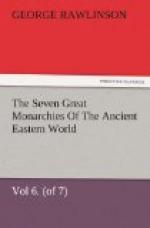The victory of Hormuz did not, however, absolutely decide the contest, or determine at once that the Parthian empire should fall, and the new Persian kingdom succeed into its place. Artabanus had left sons; and there were not wanting those among the feudatories of the empire, and even among the neighboring potentates, who were well inclined to embrace their cause. A certain Artavasdes seems to have claimed the throne, and to have been accepted as king, at least by a portion of the Parthians, in the year following the death of Artabanus (A.D. 227), when he certainly issued coins. The Armenian monarch, who had been set on his throne by Artabanus, and was uncle to the young princes, was especially anxious to maintain the Arsacids in power; he gave them a refuge in Armenia, collected an army on their behalf, and engaging Artaxerxes, is even said to have defeated him in a battle. But his efforts, and those of Artavasdes, were unavailing. The arms of Artaxerxes in the end everywhere prevailed. After a struggle, which cannot have lasted more than a few years, the provinces of the old Parthian empire submitted; the last Arsacid prince fell into the hands of the Persian king; and the founder of the new dynasty sought to give legitimacy to his rule by taking to wife an Arsacid princess.
Thus perished the great Parthian monarchy after an existence of nearly five centuries. Its end must be attributed in the main to internal decay, working itself out especially in two directions. The Arsacid race, with which the idea of the empire was bound up, instead of clinging together with that close “union” which is “strength,” allowed itself to be torn to pieces by dissensions, to waste its force in quarrels, and to be made a handle of by every foreign invader, or domestic rebel, who chose to use its name in order to cloak his own selfish projects. The race itself does not seem to have become exhausted. Its chiefs, the successive occupants of the throne, never sank into mere weaklings or faineants, never shut themselves up in their seraglios, or ceased to take a leading part, alike in civil broils, and in struggles with foreign rivals. But the hold which the race had on the population, native and foreign, was gradually weakened by the feuds which raged within it, by the profusion with which the sacred blood was shed by those in whose veins it ran, and the difficulty of knowing which living member of it was its true head, and so entitled to the allegiance of those who wished to be faithful Parthian subjects. Further, the vigor of the Parthian soldiery must have gradually declined, and their superiority over the mass of the nations under their dominion have diminished. We found reasons for believing that, as early as A.D. 58, Hyrcania succeeded in throwing off the Parthian yoke, and thus setting an example of successful rebellion to the subject peoples. The example may have been followed in cases of which we hear nothing; for the condition of the more remote portions of the empire




